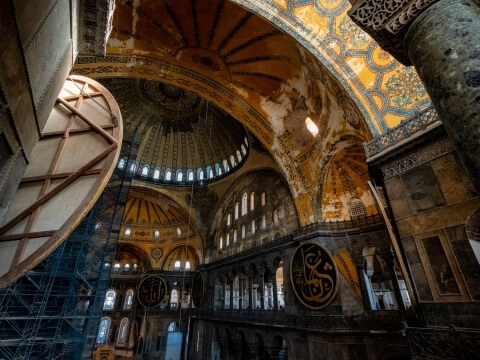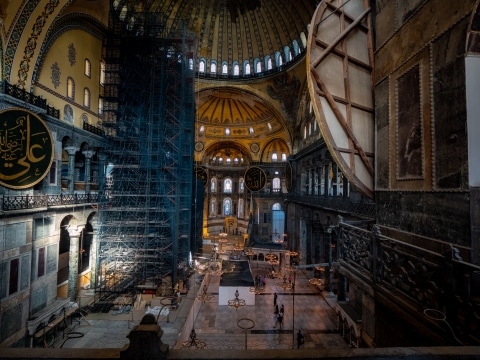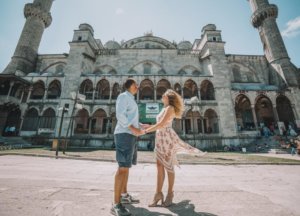A journey to Istanbul can not be complete without a visit to the Hagia Sophia.
La basilique Sainte-Sophie (du grec Ἁγία Σοφία / Hagía Sophía, qui signifie « sagesse de Dieu », « sagesse divine », nom repris en turc sous la forme Ayasofya) est une grande basilique chrétienne de Constantinople construite dans un premier temps au 4e siècle, puis reconstruite bien plus grande au 5e siècle, sous l’empereur byzantin Justinien, où elle a acquis sa forme actuelle. Elle est devenue mosquée au 15e siècle sous Mehmet II. Elle est située sur la péninsule historique d’Istanbul. Depuis 1934, elle n’est plus un lieu de culte mais un musée. Son esplanade est à la mesure de la gloire de Byzance. La basilique Sainte-Sophie (du grec Ἁγία Σοφία / Hagía Sophía, qui signifie « sagesse de Dieu », « sagesse divine », nom repris en turc sous la forme Ayasofya) est une grande basilique chrétienne de Constantinople construite dans un premier temps au 4e siècle, puis reconstruite bien plus grande au 5e siècle, sous l’empereur byzantin Justinien, où elle a acquis sa forme actuelle. Elle est devenue mosquée au 15e siècle sous Mehmet II. Elle est située sur la péninsule historique d’Istanbul. Depuis 1934, elle n’est plus un lieu de culte mais un musée. Son esplanade est à la mesure de la gloire de Byzance. 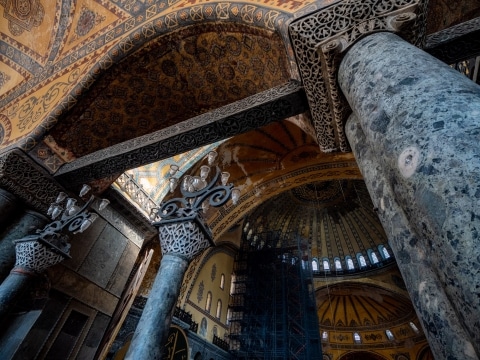
La basilique Sainte-Sophie (du grec Ἁγία Σοφία / Hagía Sophía, qui signifie « sagesse de Dieu », « sagesse divine », nom repris en turc sous la forme Ayasofya) est une grande basilique chrétienne de Constantinople construite dans un premier temps au 4e siècle, puis reconstruite bien plus grande au 5e siècle, sous l’empereur byzantin Justinien, où elle a acquis sa forme actuelle. Elle est devenue mosquée au 15e siècle sous Mehmet II. Elle est située sur la péninsule historique d’Istanbul. Depuis 1934, elle n’est plus un lieu de culte mais un musée. Son esplanade est à la mesure de la gloire de Byzance. 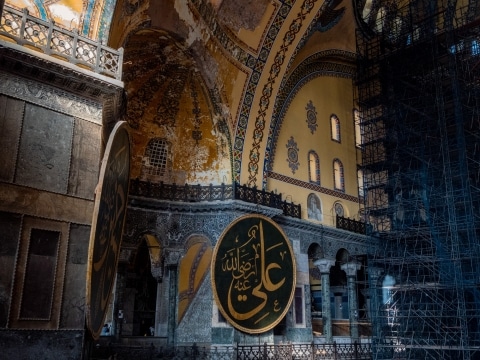
La basilique Sainte-Sophie (du grec Ἁγία Σοφία / Hagía Sophía, qui signifie « sagesse de Dieu », « sagesse divine », nom repris en turc sous la forme Ayasofya) est une grande basilique chrétienne de Constantinople construite dans un premier temps au 4e siècle, puis reconstruite bien plus grande au 5e siècle, sous l’empereur byzantin Justinien, où elle a acquis sa forme actuelle. Elle est devenue mosquée au 15e siècle sous Mehmet II. Elle est située sur la péninsule historique d’Istanbul. Depuis 1934, elle n’est plus un lieu de culte mais un musée. Son esplanade est à la mesure de la gloire de Byzance. 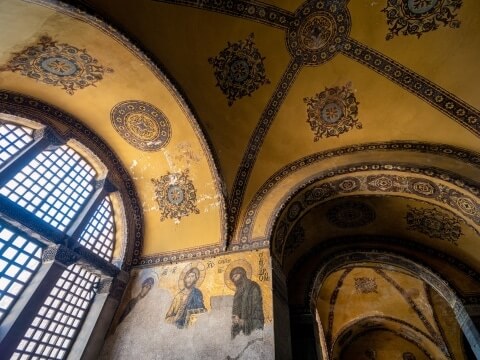
La basilique Sainte-Sophie (du grec Ἁγία Σοφία / Hagía Sophía, qui signifie « sagesse de Dieu », « sagesse divine », nom repris en turc sous la forme Ayasofya) est une grande basilique chrétienne de Constantinople construite dans un premier temps au 4e siècle, puis reconstruite bien plus grande au 5e siècle, sous l’empereur byzantin Justinien, où elle a acquis sa forme actuelle. Elle est devenue mosquée au 15e siècle sous Mehmet II. Elle est située sur la péninsule historique d’Istanbul. Depuis 1934, elle n’est plus un lieu de culte mais un musée. Son esplanade est à la mesure de la gloire de Byzance. 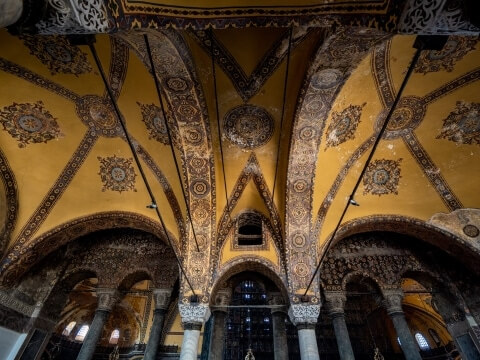
La basilique Sainte-Sophie (du grec Ἁγία Σοφία / Hagía Sophía, qui signifie « sagesse de Dieu », « sagesse divine », nom repris en turc sous la forme Ayasofya) est une grande basilique chrétienne de Constantinople construite dans un premier temps au 4e siècle, puis reconstruite bien plus grande au 5e siècle, sous l’empereur byzantin Justinien, où elle a acquis sa forme actuelle. Elle est devenue mosquée au 15e siècle sous Mehmet II. Elle est située sur la péninsule historique d’Istanbul. Depuis 1934, elle n’est plus un lieu de culte mais un musée. Son esplanade est à la mesure de la gloire de Byzance. 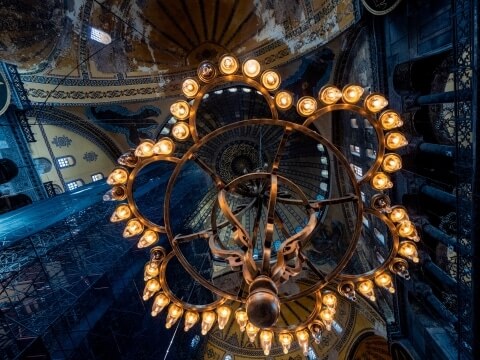
La basilique Sainte-Sophie (du grec Ἁγία Σοφία / Hagía Sophía, qui signifie « sagesse de Dieu », « sagesse divine », nom repris en turc sous la forme Ayasofya) est une grande basilique chrétienne de Constantinople construite dans un premier temps au 4e siècle, puis reconstruite bien plus grande au 5e siècle, sous l’empereur byzantin Justinien, où elle a acquis sa forme actuelle. Elle est devenue mosquée au 15e siècle sous Mehmet II. Elle est située sur la péninsule historique d’Istanbul. Depuis 1934, elle n’est plus un lieu de culte mais un musée. Son esplanade est à la mesure de la gloire de Byzance. 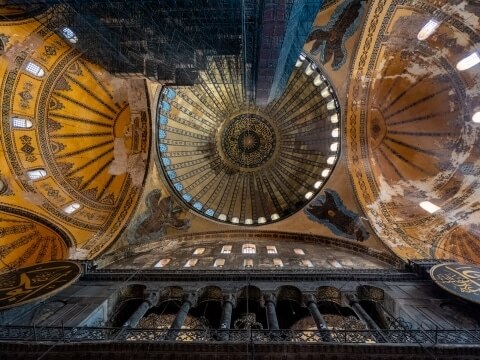
La basilique Sainte-Sophie (du grec Ἁγία Σοφία / Hagía Sophía, qui signifie « sagesse de Dieu », « sagesse divine », nom repris en turc sous la forme Ayasofya) est une grande basilique chrétienne de Constantinople construite dans un premier temps au 4e siècle, puis reconstruite bien plus grande au 5e siècle, sous l’empereur byzantin Justinien, où elle a acquis sa forme actuelle. Elle est devenue mosquée au 15e siècle sous Mehmet II. Elle est située sur la péninsule historique d’Istanbul. Depuis 1934, elle n’est plus un lieu de culte mais un musée. Son esplanade est à la mesure de la gloire de Byzance. 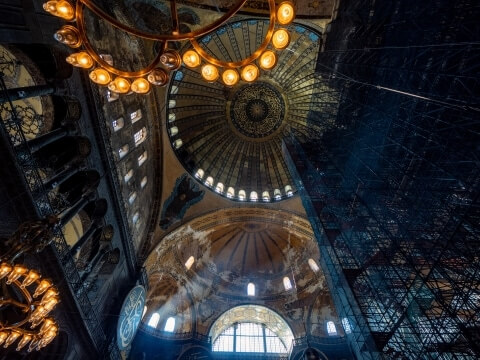
La basilique Sainte-Sophie (du grec Ἁγία Σοφία / Hagía Sophía, qui signifie « sagesse de Dieu », « sagesse divine », nom repris en turc sous la forme Ayasofya) est une grande basilique chrétienne de Constantinople construite dans un premier temps au 4e siècle, puis reconstruite bien plus grande au 5e siècle, sous l’empereur byzantin Justinien, où elle a acquis sa forme actuelle. Elle est devenue mosquée au 15e siècle sous Mehmet II. Elle est située sur la péninsule historique d’Istanbul. Depuis 1934, elle n’est plus un lieu de culte mais un musée. Son esplanade est à la mesure de la gloire de Byzance. 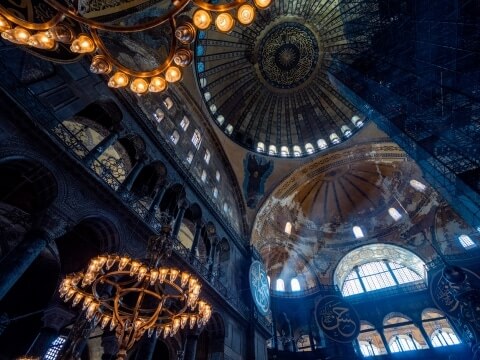
La basilique Sainte-Sophie (du grec Ἁγία Σοφία / Hagía Sophía, qui signifie « sagesse de Dieu », « sagesse divine », nom repris en turc sous la forme Ayasofya) est une grande basilique chrétienne de Constantinople construite dans un premier temps au 4e siècle, puis reconstruite bien plus grande au 5e siècle, sous l’empereur byzantin Justinien, où elle a acquis sa forme actuelle. Elle est devenue mosquée au 15e siècle sous Mehmet II. Elle est située sur la péninsule historique d’Istanbul. Depuis 1934, elle n’est plus un lieu de culte mais un musée. Son esplanade est à la mesure de la gloire de Byzance. 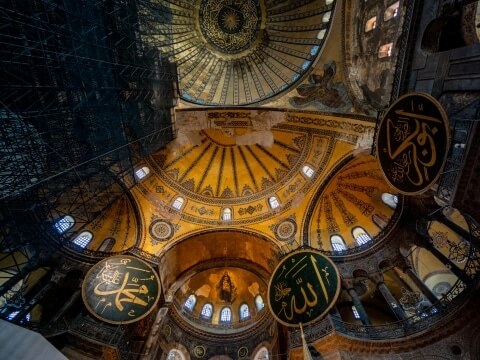
La basilique Sainte-Sophie (du grec Ἁγία Σοφία / Hagía Sophía, qui signifie « sagesse de Dieu », « sagesse divine », nom repris en turc sous la forme Ayasofya) est une grande basilique chrétienne de Constantinople construite dans un premier temps au 4e siècle, puis reconstruite bien plus grande au 5e siècle, sous l’empereur byzantin Justinien, où elle a acquis sa forme actuelle. Elle est devenue mosquée au 15e siècle sous Mehmet II. Elle est située sur la péninsule historique d’Istanbul. Depuis 1934, elle n’est plus un lieu de culte mais un musée. Son esplanade est à la mesure de la gloire de Byzance. 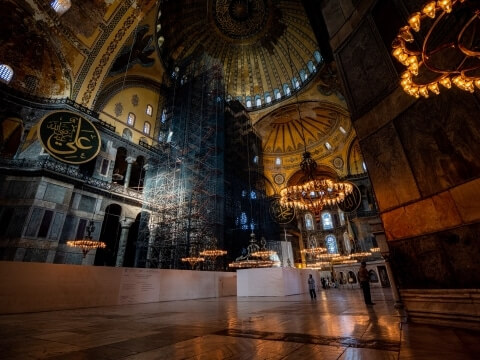
La basilique Sainte-Sophie (du grec Ἁγία Σοφία / Hagía Sophía, qui signifie « sagesse de Dieu », « sagesse divine », nom repris en turc sous la forme Ayasofya) est une grande basilique chrétienne de Constantinople construite dans un premier temps au 4e siècle, puis reconstruite bien plus grande au 5e siècle, sous l’empereur byzantin Justinien, où elle a acquis sa forme actuelle. Elle est devenue mosquée au 15e siècle sous Mehmet II. Elle est située sur la péninsule historique d’Istanbul. Depuis 1934, elle n’est plus un lieu de culte mais un musée. Son esplanade est à la mesure de la gloire de Byzance.
Hagia Sophia (/ˈhɑːɡiə soʊˈfiːə/; from the Greek Αγία Σοφία, pronounced [aˈʝia soˈfia], “Holy Wisdom“; Latin: Sancta Sophia or Sancta Sapientia; Turkish: Ayasofya) is the former Greek Orthodox Christian patriarchal cathedral, later an Ottoman imperial mosque and now a museum (Ayasofya Müzesi) in Istanbul, Turkey. Built in 537 AD at the beginning of the Middle Ages, it was famous in particular for its massive dome. It was the world’s largest building and an engineering marvel of its time. It is considered the epitome of Byzantine architecture[1] and is said to have “changed the history of architecture”.[2]
From the date of its construction in 537 until 1453, it served as an Eastern Orthodox cathedraland the seat of the Ecumenical Patriarch of Constantinople,[3] except between 1204 and 1261, when it was converted by the Fourth Crusaders to a Roman Catholic cathedral under the Latin Empire. The building was later converted into an Ottoman mosque from 29 May 1453 until 1931. It was then secularized and opened as a museum on 1 February 1935.[4] It remained the world’s largest cathedral for nearly a thousand years, until Seville Cathedral was completed in 1520.
The current building was originally constructed as a church between 532 and 537 on the orders of the Byzantine Emperor Justinian I and was the third Church of the Holy Wisdom to occupy the site, the prior one having been destroyed by rioters in the Nika Revolt. It was designed by the Greek geometers Isidore of Miletus and Anthemius of Tralles.[5] The church was dedicated to the Wisdom of God, the Logos, the second person of the Trinity,[6] its patronal feast taking place on 25 December, the commemoration of the birth of the incarnation of the Logos in Christ.[6]Although sometimes referred to as Sancta Sophia (as though it were named after Sophia the Martyr), sophia being the phonetic spelling in Latin of the Greek word for wisdom, its full name in Greek is Ναός της Αγίας του Θεού Σοφίας, Naos tēs Hagias tou Theou Sophias, “Shrine of the Holy Wisdom of God”.[7][8] The church contained a large collection of relics and featured, among other things, a 15-metre (49 ft) silver iconostasis.[citation needed] The focal point of the Eastern Orthodox Church for nearly one thousand years, the building witnessed the excommunication of Patriarch Michael I Cerularius officially communicated by Humbert of Silva Candida, the papal envoy of Pope Leo IXin 1054, an act that is commonly considered the start of the East–West Schism.
In 1453, Constantinople was conquered by the Ottoman Empire under Mehmed the Conqueror, who ordered this main church of Orthodox Christianity converted into a mosque. Although some parts of the city of Constantinople were falling into disrepair, the cathedral was maintained with an amount of money set aside for this purpose. Nevertheless, the Christian cathedral made a strong impression on the new Ottoman rulers and they decided to convert it into a mosque.[9][10] The bells, altar, iconostasis, and other relics were destroyed and the mosaics depicting Jesus, his Mother Mary, Christian saints, and angels were also destroyed or plastered over. Islamic features—such as the mihrab (a niche in the wall indicating the direction toward Mecca, for prayer), minbar (pulpit), and four minarets—were added. It remained a mosque until 1931 when it was closed to the public for four years. It was re-opened in 1935 as a museum by the Republic of Turkey. Hagia Sophia was, as of 2014, the second-most visited museum in Turkey, attracting almost 3.3 million visitors annually.[11] According to data released by the Turkish Culture and Tourism Ministry, Hagia Sophia was Turkey’s most visited tourist attraction in 2015.[12]
From its initial conversion until the construction of the nearby Sultan Ahmed Mosque (Blue Mosque of Istanbul) in 1616, it was the principal mosque of Istanbul. The Byzantine architecture of the Hagia Sophia served as inspiration for many other Ottoman mosques, such as the aforementioned mosque, the Şehzade Mosque, the Süleymaniye Mosque, the Rüstem Pasha Mosque and the Kılıç Ali Pasha Complex.
Its architecture has been a source of inspiration for the many mosques in Istanbul, but also for many others around the world. The coexistence of the spiritual and architectural worlds of Christendom and the Muslim world makes it a unique place. Nothing more to say than Wow!
